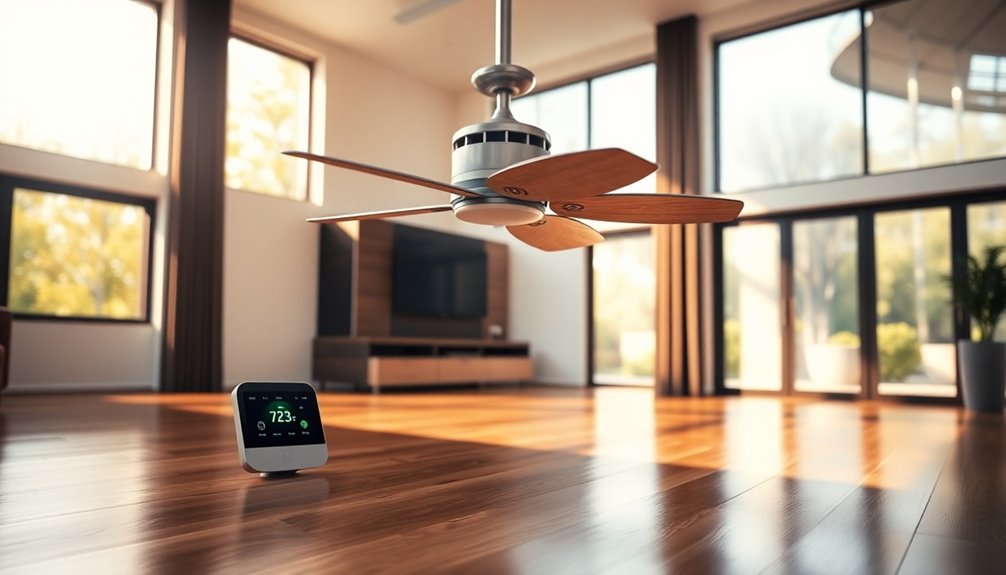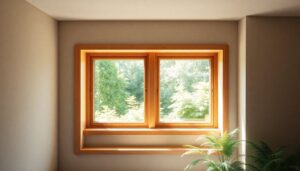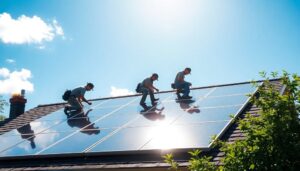Yes, you can use a vent fan on ceiling air vents to improve air circulation and potentially save energy. This setup helps remove stale air and allows for better temperature distribution, which can lower your reliance on heating and cooling systems. However, it's crucial to guarantee proper installation and sizing to avoid increased duct leakage and airflow issues. There's more to take into account when maximizing energy efficiency and maintaining your system.
Understanding Vent Fans and Their Functionality
When you think about improving your home's air quality, understanding vent fans and their functionality is essential. Vent fans are designed to remove stale indoor air and expel it outside, enhancing air circulation. Unlike ceiling air vents that distribute conditioned air, vent fans create effective ventilation, especially when used alongside other methods. Proper installation and sizing of vent fans are vital to guarantee they function efficiently without disrupting your HVAC systems. Additionally, conducting regular audits of your ventilation system can help identify areas for improvement and ensure optimal performance. Expense tracking tools can also support financial management in maintaining and improving home systems. Moreover, monitoring savings and investments related to home improvements can provide insights into long-term financial benefits. Inadequate sizing can lead to negative pressure, reducing overall energy efficiency. Regular maintenance, including cleaning and checking for blockages, keeps vent fans effective and helps maintain ideal air quality.
Benefits of Using Vent Fans on Ceiling Air Vents
Using vent fans on ceiling air vents can greatly enhance your home's air circulation and comfort.
By improving air flow, these vent fans promote even temperature distribution, which means you can rely less on your heating and cooling systems. This can lead to significant energy savings, as you can set your thermostat higher during summer months without sacrificing comfort. Additionally, automated savings through optimized energy usage can help further reduce your utility bills. Effective budgeting for energy costs can also lead to better financial management in the long run.
Moreover, vent fans help remove hot air from your home, reducing the need for air conditioning and cutting down on energy costs. They also facilitate the exchange of indoor air with fresh outdoor air, minimizing stale air and improving your indoor air quality. Moreover, sustainable delivery practices can further contribute to overall energy efficiency in your home by optimizing resource use.
Just make sure to adjust your HVAC settings accordingly for best results.
Potential Drawbacks of Vent Fans
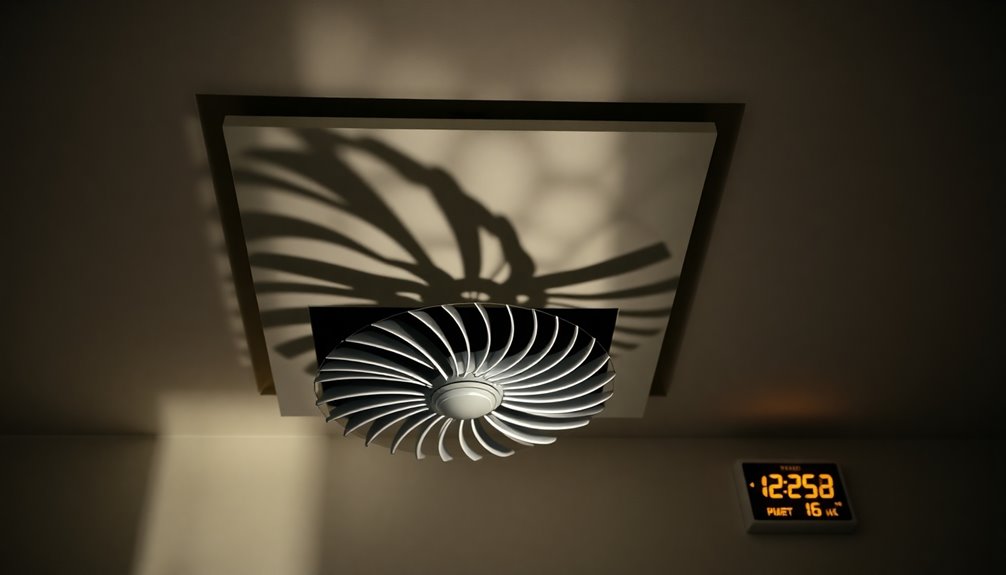
While vent fans can enhance airflow, they also come with potential drawbacks you should consider.
You might find that they draw in unpleasant or unhealthy air, compromising your indoor air quality. Additionally, if not installed correctly, they can increase duct leakage, leading to energy inefficiency and higher utility bills. Moreover, timely payments for any necessary repairs or adjustments to your ventilation system can help maintain its efficiency and effectiveness. This is crucial, as automated bill payment notifications can assist you in managing these expenses effectively. To ensure you stay on top of these costs, consider using a tool that provides custom reminders tailored to your payment schedule.
Increased Duct Leakage
Although vent fans can enhance ventilation, they often lead to increased duct leakage, which poses significant drawbacks. When you use a vent fan, the higher pressure in your duct system can disrupt airflow and cause air to escape through leaks. This not only raises energy consumption but also adds strain to your HVAC system, potentially leading to more frequent maintenance and higher operational costs.
| Issue | Impact on Energy Consumption | Effect on Air Quality |
|---|---|---|
| Increased Duct Leakage | Higher costs for heating/cooling | Unfiltered outside air enters |
| Disrupted Airflow | Inefficient system operation | Decreased comfort levels |
| Strain on HVAC System | Frequent repairs needed | Potential allergens indoors |
In the end, the benefits of ventilation may not outweigh these consequences.
Poor Air Quality
Poor air quality can arise when vent fans inadvertently draw unhealthy air particles from outside, compromising your indoor environment.
If your vent fans are incorrectly installed, they may contribute to increased noise levels, making your living space uncomfortable.
Furthermore, in certain climate zones, the performance of these fans can degrade, leading to inefficiencies that worsen air quality.
Closing vents while using vent fans can increase duct leakage, allowing unfiltered air laden with contaminants and allergens to seep into your home.
This trapped air in closed-off areas can further elevate the concentration of these harmful particles, negatively impacting your health.
It's vital to reflect on these factors to maintain a healthy indoor atmosphere while using vent fans effectively.
Energy Savings From Improved Air Circulation
With improved air circulation from ceiling fans, you can enjoy enhanced comfort while cutting down on energy costs. By adjusting temperatures and promoting a consistent airflow, you might find yourself comfortable at higher thermostat settings. This simple change can lead to noticeable savings throughout the year. Additionally, budget apps can help you track and manage your energy expenses efficiently, ensuring you're making the most of your savings. Implementing zero-based budgeting can further enhance your financial oversight by assigning every dollar a specific purpose. Furthermore, utilizing investment tracking tools can help you monitor the impact of your energy savings on your overall financial health.
Enhanced Comfort Levels
When you use a vent fan alongside your heating and cooling systems, you'll notice a significant boost in comfort levels throughout your space.
The enhanced air movement from the vent fan creates a wind chill effect, making you feel cooler without needing to lower the thermostat.
Pairing vent fans with ceiling fans helps maintain uniform temperatures, allowing you to adjust your thermostat and save energy—about 5% for each degree increase.
Additionally, proper air circulation can reduce temperature differences between floors, enhancing comfort and productivity, especially in extreme conditions.
Reduced Energy Costs
By utilizing a vent fan on ceiling air vents, you can considerably cut your energy costs while improving air circulation throughout your home. This simple addition can reduce reliance on heating and cooling systems, leading to energy savings of 10 to 15%. With ceiling fans adjusting temperatures by 4 to 8 degrees, you can set your thermostat higher, further decreasing energy expenses. Energy-efficient ceiling fans save an average of 151 kWh annually, enhancing overall savings.
| Benefit | Energy Savings (%) | Additional Savings (kWh) |
|---|---|---|
| Vent Fan Efficiency | 10-15% | – |
| Ceiling Fan Usage | 4-8 degrees | 151 |
| Improved Air Circulation | – | – |
| Heating Demand Reduction | – | – |
| Overall Comfort | – | – |
Installation Considerations for Vent Fans
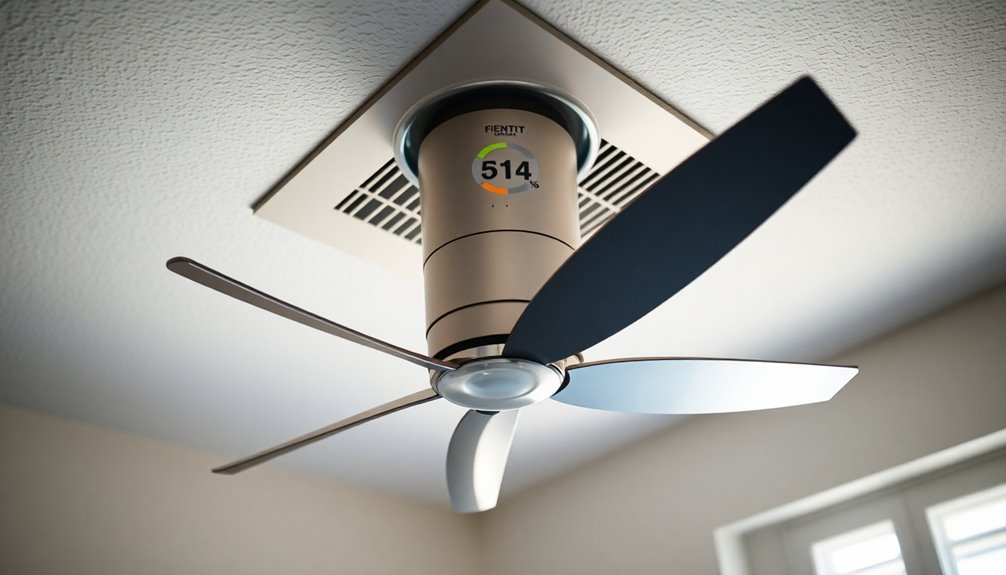
Installing vent fans involves several important considerations to guarantee they operate efficiently and safely.
First, you'll want to verify proper sizing; choosing the right size fan is essential for effective airflow without excessive energy consumption. Utilizing price comparison tools can help you find the best deals on vent fans. Additionally, comprehensive price comparison can empower consumers to secure the best prices while shopping for necessary equipment.
Next, consider that dedicated electrical circuits may be necessary to avoid overloads, guaranteeing reliable operation.
You might also need to increase your attic ventilation capacity to accommodate the additional airflow and prevent negative pressure issues.
Finally, sealing the vent fan properly when it's not in use can greatly enhance energy efficiency by minimizing heat transfer and stabilizing your indoor temperature. Additionally, ensuring proper integration with existing systems can maximize the overall effectiveness of your ventilation strategy.
Maintenance Tips for Optimal Performance
To keep your vent fan operating at its best, regular maintenance is essential.
Start by cleaning and replacing air filters often to guarantee proper airflow; clogged filters can reduce efficiency by up to 15%.
Inspect and clean the fan blades and housing at least once a year to prevent dust buildup that hinders airflow and increases energy consumption.
Make sure the vent fan is properly sealed and insulated to minimize energy loss.
Check for any blockages in the ductwork, as obstructions can cut airflow by 30%.
Finally, schedule annual maintenance with a certified HVAC professional to catch potential issues early and keep your vent fan running smoothly, ultimately extending its lifespan and enhancing energy efficiency.
Alternatives to Vent Fans for Energy Efficiency
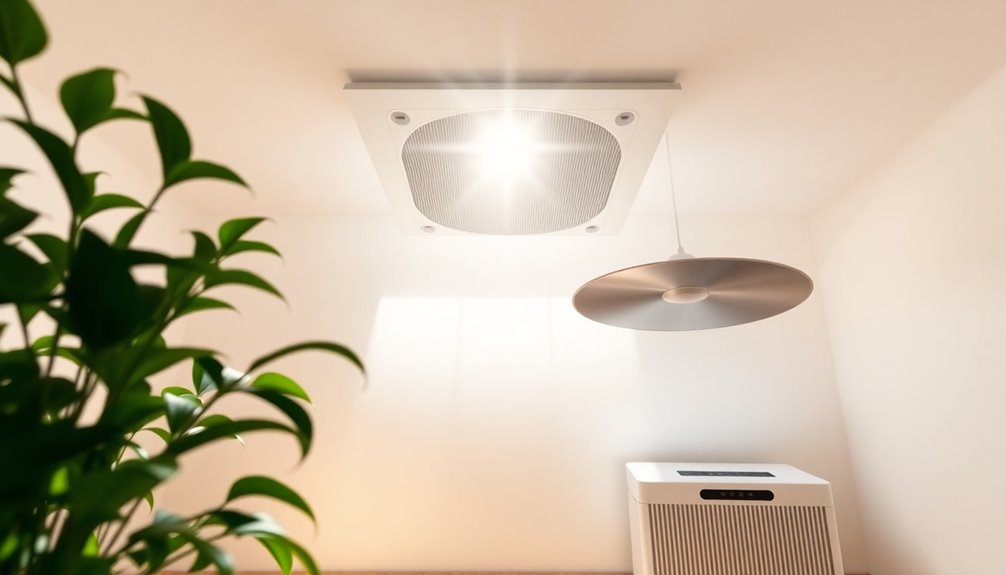
While maintaining your vent fan is important for performance, exploring alternatives can further enhance your energy efficiency.
Consider using ceiling fans, which effectively circulate cooler air and allow you to raise your thermostat settings, potentially saving 5% on energy costs for each degree increase.
Whole-house fans can also be a great option, providing home-wide air circulation and reducing air conditioning use when outdoor temperatures are cooler.
Opt for Energy Star-rated ceiling fans that save an average of 151 kWh per year compared to standard fans.
Additionally, smart ceiling fans that sync with smart thermostats can optimize energy savings by adjusting operation based on temperature and usage patterns.
Regular maintenance of these fans further enhances their energy efficiency and lifespan.
Conclusion
To summarize, using a vent fan on ceiling air vents can enhance your home's airflow and potentially save you energy. Did you know that proper air circulation can reduce heating and cooling costs by up to 30%? By improving your ventilation, you not only create a more comfortable environment but also contribute to energy efficiency. Just remember to take into account installation and maintenance to get the best results from your vent fan. Happy saving!

